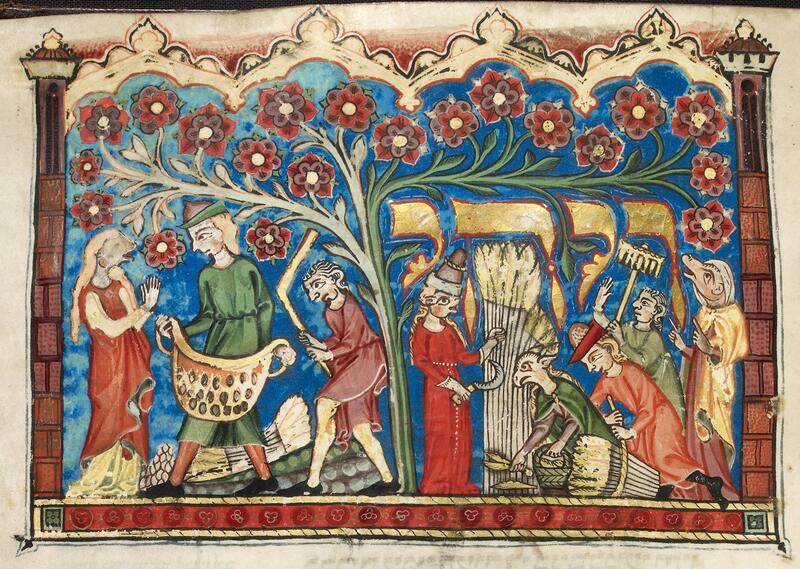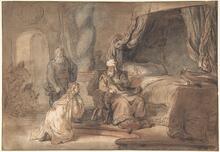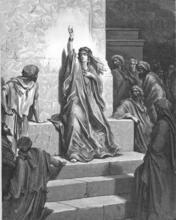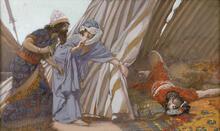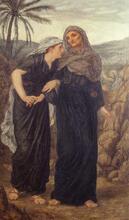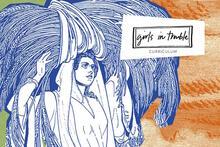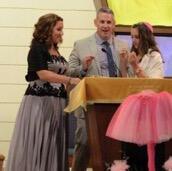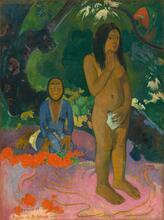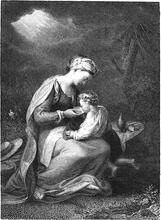Ruth: Midrash and Aggadah
Ruth is related to many of the other women featured prominently in the Bible, including her sister Orpah and her mother-in-law Naomi. Ruth converts just before her second marriage, to Boaz, and is guided through her conversion by Naomi. Although Naomi is portrayed as suspicious of Ruth and her choice to convert, the Rabbis clarify that Ruth converted based on her belief. However, Boaz dies on his wedding night, leaving Naomi and Ruth widowed together. The midrash views Ruth very positively, describing her as beautiful, modest, and virtuous. The Rabbis also link Ruth with other revered women such as Sarah and Rebekah, furthering her portrayal as an exemplary biblical woman.
Lineage
The Rabbis state that Ruth was Orpah’s sister, as well as her sister-in-law, and both were the daughters of King Eglon of Moab (Ruth Rabbah 2:9), who (according to the same A type of non-halakhic literary activitiy of the Rabbis for interpreting non-legal material according to special principles of interpretation (hermeneutical rules).midrash) was the son of Balak. This fact transforms them from simple Moabite women to members of the royal family. Their lineage is significant because of David’s descent from Ruth: David’s Moabite origins are linked to royalty. Ruth and David’s being descended from Eglon and Balak is considered to be a reward for them: Balak—for establishing altars (that he intended to aid Balaam in cursing Israel); and Eglon—for arising upon hearing the name of God from Ehud son of Gera (who actually sought to kill the king).
History
According to Ruth Zuta (1:2), Mahlon was worthier than Chilion. His name is expounded: “Mahlon—an expression of mehilah [pardon],” and he therefore deserved to be married to Ruth the Moabite. According to R. Meir (Ruth Rabbah 2:9), Ruth did not convert during her marriage to Mahlon, even though her husband could have converted her. Zohar Hadash on Ruth (fol. 79a) cites a view that Mahlon did convert Ruth, and even gave her this name; this conversion, however, was solely for the purpose of matrimony and only afterwards did she fully accept the Jewish religion. In contrast with Orpah, Ruth was loyal to her mother-in-law and elected to accompany her on her return to Bethlehem: “[…] and Orpah kissed her mother-in-law farewell. But Ruth clung to her” (Ruth 1:14). This led the Rabbis to call Orpah “the one who kissed,” and Ruth, “the one who clung” (BT Suspected adulteressSotah 42b). Ruth is also compared to Judah’s wife Tamar for her selfless action to ensure the continuation of the line of the house of Judah (Ruth Zuta 1:12).
The midrashim display two different orientations in their description of Naomi’s relationship with Ruth: Ruth Zuta portrays Naomi as being ashamed of her Gentile daughters-in-law and therefore as not wanting them to accompany her on her return to Bethlehem (1:8, 12). Continuing this tendency, some of the descriptions in Ruth Zuta (2:2, 18, 22) may express her strict supervision of her daughter-in-law, possibly ensuing from Naomi’s continued suspiciousness concerning her. A different pattern appears in Ruth Rabbah, in which Ruth is perceived, from the outset, as faithful to Naomi and her way.
Ruth’s joining Naomi is seen by the Rabbis, in different texts, as the process of full conversion that Ruth underwent. Their very first walking together is understood as a discussion of the laws of conversion (Ruth Rabbah 2:12) and some of these very laws are even derived from the conversation of these two women (BT Yevamot 47b). Ruth’s declaration of loyalty to Naomi: “But Ruth replied, ‘Do not urge me to leave you, to turn back and not follow you. For wherever you go, I will go; wherever you lodge, I will lodge; your people shall be my people, and your God my God. Where you die, I will die, and there I will be buried. Thus, and more may the Lord do to me if anything but death parts me from you” (1:16–17) is regarded by the midrash as a dialogue between the two women. That is, Ruth’s words—which the midrash supplements for the reader—are a response to Naomi’s description to her daughter-in-law of the mores of the Jewish religion.
Thus, the exegesis of “For wherever you go, I will go”: “She told her: ‘My daughter, it is not the way of Israel to go to theaters or to circuses, but only to synagogues and study halls. Nor is it the way of Israel to go more than two thousand cubits on the Sabbath.’ She said: ‘For wherever you go, I will go’” (Ruth Rabbah 2:22). The Amoraim of The Land of IsraelErez Israel vigorously opposed going to the Roman theater, an idolatrous venue, and the unbridled and licentious behavior that was rampant in the mixed cities. It therefore comes as no surprise that Ruth’s passage from paganism to Judaism is related to forgoing the theater and circus.
A similar exegetical presentation of a conversion appears in the BT (Yoma 42b) and in Ruth Zuta, stressing even more strongly the modesty that is now required of Ruth (similar to not attending the theater): “Ruth said: ‘I cannot return to my family and the corruption of idolatry in Father’s house.’ Then she [Naomi] instructed her […] ‘We are forbidden to be alone with an unmarried woman, and certainly so with a married woman.’ She [Ruth] said to her: ‘Wherever you lodge, I will lodge’—she [Naomi] taught her: ‘Incestuous relations are forbidden to us.’ She [Ruth] declared: ‘Your people shall be my people’—she [Naomi] told her: ‘Idolatry is forbidden to us.’ She [Ruth] said: ‘And your God my God’” (Ruth Zuta 1:12).
The emphasis upon the prohibition of a man being alone with a woman is fascinating in light of the scene in the threshing floor, in which Naomi tells Ruth to transgress this prohibition. Furthermore, the BT teaches that this ban was only imposed by the court of David after the episode of Amnon and Tamar (Sanhedrin 21a). The midrash perhaps wishes to tell us that Ruth’s behavior at the threshing floor did not ensue from Moabite norms that were unacceptable in Judah.
One of the explanations given by the Rabbis for the crowd who greeted Ruth and Naomi upon their return to Bethlehem is that these people had come for the funeral of Boaz’s wife, who had died that day (BT Bava Batra 91a; Ruth Rabbah 3:5; JT Ketubot 1:1, 25a), to which the midrash adds the dry observation: “This one went out and this one came in” (Ruth Rabbah loc. cit.). That is, Boaz’s former wife leaves the arena at just the time that Ruth enters it.
The BT (Bava Batra 91a) identifies Boaz with the judge Ibzan mentioned in Jud. 12. The latter had thirty sons and thirty daughters, and Bava Batra asserts that they all died in his lifetime. This fact creates an analogy between Boaz and Naomi—a widow who lost her sons—and between him and Ruth—both have experienced loss of a spouse. Their second marriage and the birth of their son therefore constitute a healing for both, not only for Ruth. (Ruth Rabbah also mentions Ibzan but does not identify him with Boaz. Possibly the mention of Ibzan in the passage telling of the death of Boaz’s wife led the Babylonian narrators to formulate this identification of the two characters.)
The Book of Ruth does not mention that Boaz had a wife and children. It is highly unlikely that an important established man such as Boaz would have remained a bachelor until he married Ruth; consequently, the death of his first wife and children supports the Ibzan-Boaz identification.
After this, Ruth goes to the field to glean ears of corn in the field of Boaz; the midrash accentuates her arousing Boaz’s attention by her fine behavior (Ruth Rabbah 4:9). Nonetheless, this midrash has Boaz’s servant emphasizing that this girl is a Moabite, while downplaying her actions: according to him, her mother-in-law taught her how to behave, but this is merely superficial simulation (while in Ruth Zuta [2:7] this servant sings her praises).
According to the midrash, Ruth was forty years old and not a young woman when Boaz married her, a fact that stresses the urgency of her desire to marry and bear children (Ruth Rabbah 4:4; BT SabbathShabbat 113b). The midrash puts Boaz’s age at that time as eighty (Ruth Rabbah 7:4; Ruth Zuta 4:13). Boaz tells Ruth: “Your latest deed of loyalty is greater than the first, in that you have not turned to younger men” (Ruth 3:10); even if Ruth married at an advanced age, the difference in ages between Boaz and Ruth was still great.
After Boaz and Ruth make their first acquaintance, Naomi advises Ruth to wait for him at night in the threshing floor. In the midrashic account, Ruth has reservations about such an act, but is nevertheless prepared to heed her mother-in-law, even if such behavior seems strange to her (Ruth Rabbah 5:13; Ruth Zuta 3:2).
The scene in the threshing floor is described at length by the Rabbis. Boaz is startled at first and fears that this might be an apparition (Ruth Rabbah 6:3). When he learns that she is an unmarried woman, the Rabbis portray the inner battle in Boaz’s soul, who finally overcomes his physical desires and waits for the formal ceremony of redemption (Ruth Rabbah 6:8; Sifrei on Numbers, para. 88). Aware that Ruth not only took a chance in the threshing floor but also greatly endangered herself, the midrash expresses this in different exegeses. Thus, e.g., in Ruth Rabbah 6:3: “‘A man’s fears become a trap for him, but he who trusts in the Lord shall be safeguarded [Prov. 29:25]. ‘Fear’—Ruth frightened Boaz: ‘In the middle of the night, the man gave a start and pulled back’ [Ruth 3:8]—he should have cursed her, ‘but he who trusts in the Lord shall be safeguarded’—[God] put in his heart, and he blessed her, as it is said, ‘Be blessed of the Lord, daughter!’ [Ruth 3:10].” It would have been only natural for Boaz to have cursed Ruth the moment he saw her, but the hand of God was in this, and caused him to bless her in the end. Ruth Zuta presents this scene in even stronger fashion: Ruth fears that Boaz will kill her (Ruth Zuta 3:9).
In Ruth Zuta (4:13) Boaz dies on his wedding night. This surprising tradition possibly results from the desire to absolve their marriage of any hint of personal benefit for the couple. The sole purpose of this matrimonial bond is to attain redemption for Naomi by the birth of a son. Boaz lives only until he fulfills his role, and no longer. This creates a new situation: the reestablishment of the relationship between Ruth and Naomi. Once again, both are now alone, as widows. This time, however, they have a son, with Ruth as his mother and Naomi as the foster mother.
The very birth of the child is nothing less than miraculous. According to Ruth Rabbah, Boaz was sterile, a condition that Naomi’s prayer and blessing changed (Ruth Rabbah 6:4; this contrasts with the view expressed by the BT, that identifies Boaz with Ibzan, who fathered sixty children—Bava Batra 91a). Ruth’s infertility is indicated by the biblical text, as well. The midrash claims that her pregnancy was especially miraculous, since she did not have a womb, and “God shaped a womb for her” (Ruth Rabbah 7:14). The view that Boaz died that night also explains why Naomi was the foster mother of the child born to Boaz and the now widowed Ruth.
Characteristics
The Bible describes Ruth’s loyalty to Naomi and her charitable acts, and the midrashic expansion also stresses her great modesty. This trait is already expressed in the instructions Ruth receives from Naomi upon joining the people of Israel (the bans on going to the theater, of being alone with a man, and of incest—see above, “History”) and is later accentuated in Ruth’s going to Boaz in the field. As was mentioned above, Boaz took note of her actions and “when he saw that she was pleasing and her actions were pleasing, he began to ask about her” (Ruth Rabbah 4:9). The midrash uses the same adjective (pleasing, ne’imim) used to depict Naomi, thus comparing Ruth and her actions to her mother-in-law, and thereby praising Ruth. These pleasing actions are presented mainly in the context of Ruth’s extremely modest deportment:
All the women were talking and gleaning [bending over to gather the grain], while she sat and gleaned. All the women raised the hems of their garments, while she [made sure that hers] remained down. All the women sported with the reapers, while this one concealed herself (Ruth Rabbah loc. cit.).
As Ruth sat to glean with the reapers, she turned her face away, and not even a single one of her fingers could be seen, for when she saw a standing stalk, she would stand and take it, and when she saw a fallen stalk, she would sit and gather it (Ruth Zuta 2:3).
Boaz’s regard for Ruth’s inner qualities is striking in light of the fact that the Rabbis also ascribe to her great physical beauty: “It happened, said R, Johanan, that whoever saw her would have an emission” (Ruth Rabbah 4:4; a similar depiction also appears, in relation to Rahab, in BT Lit. "scroll." Designation of the five scrolls of the Bible (Ruth, Song of Songs, Lamentations, Ecclesiastes, Esther). The Scroll of Esther is read on Purim from a parchment scroll.Megillah 15a: she, too, converted, was married to an important person and was blessed with important offspring; see Ruth Rabbah 2:1).
An additional passage that shows her modesty is the wording she uses when addressing Boaz in the threshing floor, which the midrash compares to what Potiphar’s wife said to Joseph: “‘She [Potiphar’s wife] said: “Lie with me!”’ [Gen. 39:12]—R. Samuel bar Nahman said: Cursed are the wicked, for below: ‘Spread your robe over your handmaid’ [Ruth 3:9], but this one [Potiphar’s wife] was like a beast: ‘Lie with me!’” (Gen. Rabbah 87:7). Unlike Potiphar’s wife, who acts like a beast and demands that Joseph sleep with her, Ruth says nothing explicit to Boaz, but only modestly hints. In matching fashion, the midrash portrays Boaz’s modesty and his concern for Ruth’s good name. Even after she leaves the threshing floor, Ruth still worries lest she be identified as a woman coming out from the building, and so “she girded her loins as a man” (Ruth Rabbah 7:2).
The tendency to stress Ruth’s modesty is understandable considering the need to justify the threshing floor episode. The Bible itself paints this scene in a favorable light and does not criticize Ruth. In seeking to make this scene accord with the norms of modesty practiced in their world, the Rabbis speak of Ruth’s modesty, thus stressing that her going to the threshing floor was not a frivolous action, nor was it the result of unawareness of the norms prevalent in Judah, but rather resulted solely from her compliance with Naomi’s instructions and her concern for her mother-in-law (as the midrash emphasizes, in its depiction of Ruth’s thoughts before going to the threshing floor).
Other orientations, however, are also at play in the midrashic literature. Ruth Zuta categorizes Naomi’s attitude to Ruth as suspicious, in matters of modesty as well. From the outset, she tries to send her daughters-in-law back because she is ashamed of them (Ruth Zuta 1:8) and afterwards she is anxious that Ruth go forth to gather food, but “not engage in misconduct nor be dependent upon others” (2:2); she fears lest “Heaven forfend, she join the licentious ones” (2:18). In one single instance Ruth Rabbah also relates to problematic behavior by Ruth. In his exegesis of the verse “Ruth the Moabite said, ‘He even told me: Stay close by my workers’” (Ruth 2:21), R. Hanan ben Levi states: “She is definitely a Moabite,” and then explains that she changed the wording of what Boaz told her, to stay close to his girls, and she therefore is deserving of the negative appellation of “Moabite” given her by the biblical narrator.
Ruth is presented as an exemplary figure in most of the exegetical traditions, one who accepted the Jewish religion of her own free will, based on her belief, and not merely out of loyalty to her mother-in-law. This characterization is based largely on the commitment that she makes to Naomi in the Bible, which also contains theological elements. Thus, e.g., in the exegeses in Ruth Rabbah 2:22–24 (see above). Sifrei on Numbers, para. 78, accentuates Ruth’s spiritual greatness, specifically in light of her Moabite origin.
Ruth’s modesty, coupled with her great beauty, are qualities frequently mentioned by the Rabbis in their portrayals of exemplary biblical women (Sarah, Rebekah, Tamar); her uprightness (her gathering from the ownerless crops: Ruth Rabbah 4:9) and her acts of kindness toward Naomi (Ruth Rabbah 2:14) complement the positive picture that emerges from the Bible.
One exposition even attributes prophecy to Ruth: “‘She prostrated herself with her face to the ground, and said to him, “Why are you so kind as to single me out [le-hakireni, literally, to know me]”’ (Ruth 2:10)—this teaches that she prophesied about herself, that he would know her intimately” (Ruth Rabbah 5:2). In another place, it is Boaz who knows of the greatness in store for her, of which she is unaware: “For he saw with the spirit of Divine inspiration that the Messiah, the anointed king, will come from her, but he did not reveal this to her. Consequently, he said to her [Ruth 3:12]: ‘But while it is true that I am a redeeming kinsman’” (Ruth Rabbah 3:9). The wording “and she ate her fill and had some left over” (Ruth 2:14) leads the midrash to observe that this righteous woman’s stomach must have had a special blessing, since even such a small amount of food satisfied her (Ruth Rabbah 5:6).
Offspring
A very considerable number of the midrashim relating to Ruth are devoted to her descendants from the Davidic line. This exegetic attention is based on the conception that views Ruth as primarily the great-grandmother of King David, which is the source of her exalted status. In the words of Ruth Zuta (1:1), Ruth is “the mother of royalty.”
One exposition in this spirit asserts that Ruth saw King Solomon sitting in judgment of harlots (Ruth Rabbah 2:2; BT Bava Batra 91a; Sifrei on Numbers, para. 78).
Several midrashim relate to events within the narrative reality of the Book of Ruth as allegorical allusions to the future of her descendants. Thus, for example, the series of exegeses in Ruth Rabbah 5:6 that understand Boaz’s statement to Ruth: “Come over here […]” (Ruth 2:14) as hinting at various kings from the house of David; or those that relate to the six measures of barley that Ruth received (Ruth 3:17) as indicative of six of her illustrious descendants (Ruth Rabbah 7:3; BT Sanhedrin 93b).
The blessings that Boaz and Ruth receive from the elders at the gate are similarly interpreted as referring to their future offspring, especially the Messiah, the scion of the Davidic line (Ruth Rabbah 7:14).
Acceptability
An additional subject examined by the Rabbis is that of Ruth’s acceptability: the fitness of her conversion and her ability, as a Moabite, to enter the congregation. This question is discussed in relation both to the responses of Ruth’s contemporaries and, especially, to later midrashic reactions that describe the attempts to repudiate David because of his problematic origin.
Many midrashic passages discuss the question of Ruth’s ability to convert, since the Bible forbids Ammonites and Moabites from joining the people of Israel. The Rabbis restricted this ban, limiting it to males and not females, based on the exposition of the wording of the prohibition: “‘Moabite’ and not Moabitess, ‘Ammonite’ and not Ammonitess,” thus paving the way for Ruth’s conversion. As was noted, R. Meir stressed that Mahlon and Chilion could have taken advantage of this law but chose not to. According to other traditions, this The legal corpus of Jewish laws and observances as prescribed in the Torah and interpreted by rabbinic authorities, beginning with those of the Mishnah and Talmud.halakhah was promulgated close to Ruth’s arrival: “If you had come to us in the past, we would not have received you” (JT Yevamot 8:3, 9c). The allegoric exegeses of Ruth 2:9: “And when you are thirsty, go down to the jars and drink some of [the water] that the men have drawn” that understand this “drinking” as drawing Torah she-bi-khetav: Lit. "the written Torah." The Bible; the Pentateuch; Tanakh (the Pentateuch, Prophets and Hagiographia)Torah from the righteous and the Sanhedrin (Ruth Rabbah 4:12) may be connected to the need to clarify this law (as is also indicated by the context in Ruth Rabbah). The first redeemer refused to marry Ruth because he was as yet unaware of this new halakhah and feared that he would be punished like Mahlon and Chilion (Ruth Rabbah 7:10).
Additional hermeneutical discussion that was held in the time of King David describes contemporary attitudes to Ruth’s conversion and therefore to David himself and the legitimacy of his kingdom. Such discussions, and David’s attempts to contend with those who spoke ill of him, appear in numerous texts, such as BT Yevamot 77a; JT Yevamot 8:3, 9c; Ruth Rabbah 4:1, 9; 8:1. The legitimacy of the house of David is patently of cardinal importance, in light of the centrality of the Davidic line in Jewish historiography.
Other expositions relating to the question of Ruth’s acceptability compare her to the daughters of Lot (the mothers of Ammon and Moab) and to Tamar (the progenitor of the tribe of Judah), who also acted in a problematic manner to bring children into the world. In most instances, the midrashim claim that they acted for Heaven’s sake and ascribe many merits to them. Comparing Ruth to these women grants legitimacy to the episode of the threshing floor and to our understanding of the essentiality of Ruth, like Tamar, for the tribe of Judah. It is noteworthy that the Bible itself, in the blessing by the elders, compares Ruth to Rachel, Leah and Tamar (the comparison with Lot’s daughters: Ruth Rabbah 5:14; Gen. Rabbah 51:36; the comparison with Tamar: Ruth Rabbah 8:1; Ruth Zuta 1:12, and more).
Name
Ruth’s name, unlike those of other characters in the Book of Ruth (Naomi, Chilion) has no intrinsic meaning, which did not deter the Rabbis from suggesting various etymologies that express central aspects of Ruth’s character.
As was noted above, according to Zohar Hadash on Ruth 79a, Chilion gave Ruth her name; this was not her original name, and therefore is Hebrew and not Moabite.
Ruth Rabbah (2:9) accentuates her loyalty to Naomi: “[She was named] Ruth, because she saw [ra’atah, i.e., heeded] the words of her mother-in-law.”
BT Berakhot 7b stresses her importance as the progenitor of David: “Ruth—what is the meaning of Ruth? R. Johanan said: Because she merited to have issue from her David, who saturated [she-rivahu] God with song and praises.”
Ruth Zuta (1:2) examines Ruth’s religious character, as a God-fearing woman who decided to convert: “[She was named] Ruth, because she would shake with fear [meratetet] at transgression, to do the will of her father in Heaven.”
All these suggestions indicate the exceedingly positive manner in which the Rabbis perceived Ruth.
Chan, Man Ki, and Pieter M. Venter. "Midrash as exegetical approach of early Jewish exegesis, with some examples from the Book of Ruth." HTS Theological Studies 66, no. 1 (2010): 1-6.
Neusner, Jacob. A Theological Commentary to the Midrash: Ruth Rabbah and Esther Rabbah I. Vol. 6. University Press of America, 2001.
Rofé, Alexander. "Ruth 4: 11 LXX–A Midrashic Dramatization." Textus 20, no. 1 (2000): 129-140.

